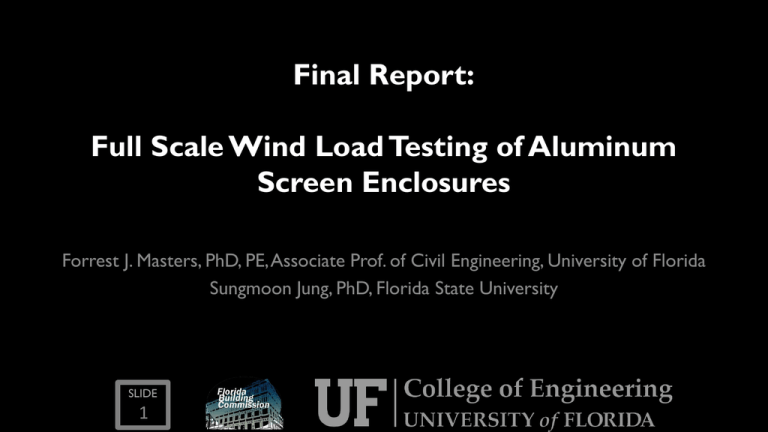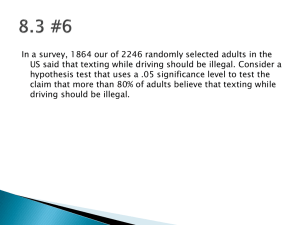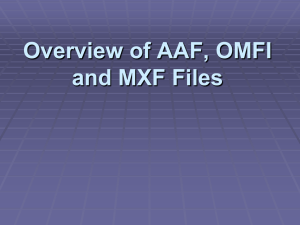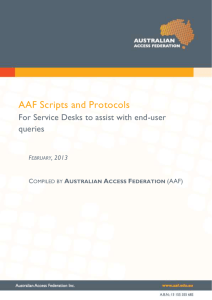Presentation - Florida Building Code
advertisement

Final Report: Full Scale Wind Load Testing of Aluminum Screen Enclosures Forrest J. Masters, PhD, PE, Associate Prof. of Civil Engineering, University of Florida Sungmoon Jung, PhD, Florida State University SLIDE 1 Presentation Outline • Specimen selection process • Full-scale testing – Set up – Design load (FBC) vs. applied load – Key observations • Material testing • Comparison of test and analysis • Implications to the code SLIDE 2 Selection of the “Generic” Specimen • AAF acquired 35 signed and sealed, site-specific plans from the St. Johns County Building Department and the City of Jacksonville. • Ten designs with a mansard roof with approximate dimensions of 24 ft X 40 ft X 9 ft and a 48 in rise in the roof were selected, de-identified, and forwarded to Dr. Jung (FSU) to review • A design with average structural performance was selected • In order to rank the candidate designs objectively, raking criteria were used (performance of roof bracing, wall bracing, post, and other members) SLIDE 3 Generic Specimen SLIDE 4 Generic Specimen SLIDE 5 Generic vs. AAF Specimens • AAF designed a second specimen (same size) following the 2010 AAF Guide to Aluminum Construction in High Wind Areas. • Significant differences between the “Generic” and the “AAF” specimens – AAF has 8 additional 2 x 2 roof braces, whereas generic has none – AAF has 2 x 8 roof beams, whereas generic has 2 x 6 roof beams – AAF has 2 x 3 purlins, whereas generic has 2 x 2 purlins – – – – – AAF has a 5” super gutter, whereas generic has a 7” super gutter AAF has a 2 x 3 + 1 x 2 eave rail, whereas generic has a 2 x 2 + 1 x 2 eave rail AAF has 2 x 4 posts on the long wall, whereas generic has 2 x 5 posts AAF does not have cable bracings on the side walls Some AAF purlins require backing plates (at bracing bays) SLIDE 6 AAF Specimen SLIDE 7 AAF Specimen SLIDE 8 Preparation for the Testing • Hartshorn Custom Contracting is fabricating both specimens • AAF and FSU performed structural analysis to identify high anticipated-to-allowable stress ratio and high tension. Visual Analysis and SAP2000 were used (sample results: next slide) • The information was forwarded to IBHS to install strain gauges SLIDE 9 High anticipated-to-allowable stress, moment (%) High anticipated-to-allowable stress, buckling (%) High tension (kips is shown) SLIDE 10 High anticipated-to-allowable stress, moment (%) High anticipated-to-allowable stress, buckling (%) High tension (kips is shown) SLIDE 11 Test Set Up • • • • Tests were conducted at the IBHS Research Center Generic specimen: assembled in April 23, tested in April 24 AAF specimen: assembled in April 25, tested in April 26 Both specimens used 18 ×14 × 0.013" fiberglass mesh SLIDE 12 SLIDE 13 SLIDE 14 Sensors: Generic SLIDE 15 Sensors: AAF (A: axial, M: moment, C: cable) Experimental Procedure • Static pull tests (single point axial force) were conducted before wind tests. Results were used for finite element model calibration. • Wind tests: angle definition SLIDE 16 Experimental Procedure (cont’d) • Wind tests – Series I: 90 degree case over three wind speed intensities with and without turbulence (Runs 1 to 6) – Series II: repeated most of Series I across a range of wind angles (Runs 7 to 24) – Series III: gradually increased the wind speed for 0 degree and 90 degree wind angles (Runs 25 to 30) – Series IV: tests at maximum wind speed for various scenarios (Generic: Runs 31 to 33, AAF: Runs 31 to 40) SLIDE 17 Design vs. Applied Wind Loading • The following figures compare design wind loading (FBC) and applied wind loading (IBHS) – FBC: 120 mph, exposure B were used for both specimens – IBHS: 90 mph, assumed a factor of 0.7 (includes gust effect, drag, screen) • In principle, no failure should have occurred in the test IBHS pressure @ 33 ft = 14.5 psf 10 10 8 8 6 IBHS (90 mph) 4 FBC (ASD) FBC (LRFD) 2 0 0 SLIDE 5 10 15 Windward Pressure (psf) IBHS pressure @ 33 ft = 14.5 psf 12 Height (ft) Height (ft) 12 6 IBHS (90 mph) 4 FBC (ASD) FBC (LRFD) 2 0 20 0 5 10 15 Leeward Pressure (psf) 20 Key Observations During the Test • Screens/attachments began to fail at 80 mph Generic, max V = 80 mph SLIDE AAF, max V = 80 mph Key Observations (cont’d) • Several screen attachments failed at 90 ~ 100 mph Generic, max V = 90 mph Failed screens and/or screen attachments (fully failed ones only), after all 90 mph tests SLIDE Key Observations (cont’d) • Generic specimen lost one corner post at 90 mph SLIDE Key Observations (cont’d) • AAF specimen lost two corner posts at 100 mph • The failure was due to the unbalanced loading (& failed attachment) SLIDE Summary of the Tests 90 mph 100 mph Retrofit Generic 80 mph • 100 mph @ 270 deg. and 0 deg., no substantial damage Structural failure of the corner post, and failure of four screens and/or attachments AAF Retrofit Partial failure of screen attachments • Unable to load @ 90 deg. (no screen at the corner due to the damage) SLIDE Partial failure of screen attachments Failure of two screens and/or attachments Structural failure of two corner posts Material Testing • Material testing was conducted to confirm the material performance SLIDE 24 Material Testing (cont’d) • Specified: 6005-T5 (E = 10,100 ksi, 𝜎𝑦 = 35.0 ksi, 𝜎𝑢 = 38.0 ksi) • Actual performance: E = 9,300 ksi, 𝜎𝑦 = 27.8 ksi, 𝜎𝑢 = 34.0 ksi – 𝜎𝑦 and 𝜎𝑢 are estimated statistically – 𝜎𝑦 : N = 12, mean = 32.3 ksi, standard deviation = 1.2 ksi – 𝜎𝑢 : N = 12, mean = 37.5 ksi, standard deviation = 0.9 ksi SLIDE 25 Model Calibration • Using the results from pull tests, three different modeling assumptions were compared Model A: baseline SLIDE 26 Model B: boundary conditions prevent rotation Model C: Model B + frame end-releases are fixed except purlins and corner bracings Model Calibration (cont’d) 9.0E-2 6.0E-2 Axial Analysis (kips) • Finite element results were compared to sensor readings • Model C was chosen for further analysis • Sample results on the right: axial forces, AAF, pull 01 -6.0E-2 3.0E-2 Model A Model B 0.0E+0 -3.0E-2 0.0E+0 Model C 3.0E-2 -3.0E-2 -6.0E-2 Axial Experiment (kips) SLIDE 27 6.0E-2 9.0E-2 Comparison of Design vs. Test 1.0E+0 5.0E-1 Data Lower Than Analysis Axial Analysis (kips) • For 80 mph and 90 mph tests, test results (x-axis) were compared to the analysis results (y-axis) • Analysis used FBC loading. Therefore, in principle, all test results should be lower than analysis results. • Marked notable locations (a sample comparison is shown on the right) -1.5E+0 -1.0E+0 -5.0E-1 0.0E+0 0.0E+0 -5.0E-1 -1.5E+0 Axial Experiment (kips) 28 5.0E-1 1.0E+0 80 mph -1.0E+0 SLIDE Data Higher Than Analysis 90 mph Summary of Notable Members: Generic • One corner bracing exceeded the allowable stress • High moment correlated well with screen attachment failure M-9 A-6 M-10 M-12 M-21 A-14 M-8 M-20 M-19 SLIDE 29 M-18 A-16 M-17 A-15 M-7 A-13 A-5 M-11 Actual to Allowable Stress Ratio 1.2 1.0 0.8 0.6 Max Avg 0.4 0.2 0.0 A-15 (0) M-17 (0) M-18 (0) A-1 (90) A-2 (90) M-17 (90) M-21 (90) Summary of Notable Members: AAF • Two posts exceeded the allowable stress (one of which actually failed during the testing) M-8 M-7 A-14 A-5 A-11 M-17 M-20 M-19 SLIDE 30 A-13 A-4 Actual to Allowable Stress Ratio M-21 M-9 M-18 M-10 A-6 A-12 1.4 1.2 1.0 0.8 Max 0.6 Avg 0.4 0.2 0.0 A-6 (0) M-8 (0) M-9 (0) A-4 (90) M-9 (90) M-18 (90) M-21 (90) Implications to the Code • Although the wind loading did not exceed the design loading, failures were observed: – Screens began to fail at 80 mph – Some screen attachments failed at 90 to 100 mph – Some of the failed screen attachments fluttered while attached to the structural member, contributing failure of it – One vertical post failed due to the unbalanced loading (one side had screen but the other side lost the screen) SLIDE 31 Implications to the Code (cont’d) • The failure of screen attachments and unbalanced loading have direct implications on the rule on removing the screen (Rule 61G20-1.002). If some screens are cut but not others, unbalanced loading may accelerate the failure of the post. Code changes should be considered to either require removal of all screens above the chair rail, or, devise a more secure fastening of screen attachments to prevent partial failure and unbalanced loading. SLIDE 32 Implications to the Code (cont’d) • The tensile ultimate strength and tensile yield strength of the aluminum extrusions, based on the testing of coupons harvested from the specimens, were lower than the specified values. To ensure that the aluminum meets or exceeds the specified performance levels, the building code should require that material certification be submitted to the building official. SLIDE 33 Implications to the Code (cont’d) • The tested specimens received very thorough inspection and quality control. However, it is well known that the real-world plan review and inspection may not reach such a level, and therefore, likely experience much more severe failure due to the hurricane. The code requirement on this issue would greatly reduce potential failure of screen enclosures due to the hurricane. SLIDE 34











